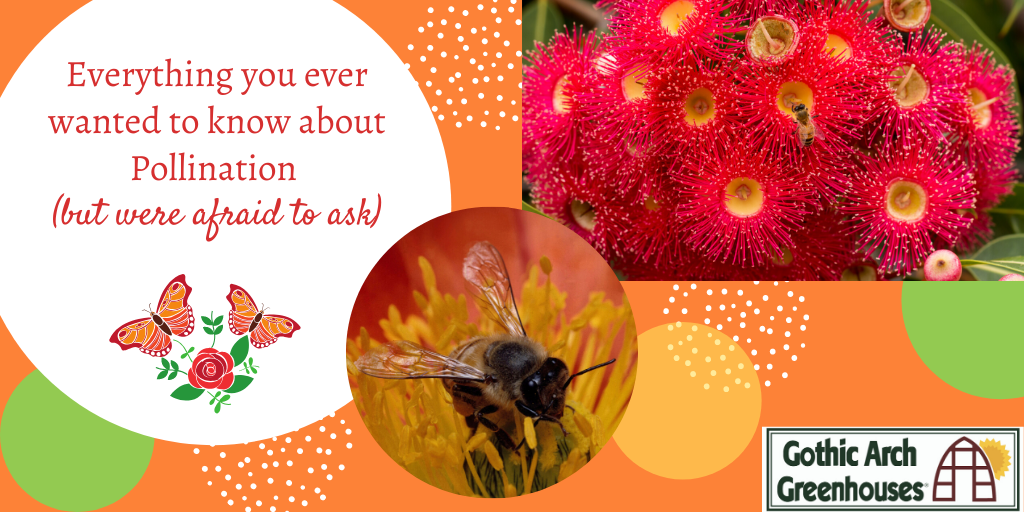
All vegetable crops that produce a fruit need pollination to produce food. In contrast to leafy greens, legumes, roots, and tubers, fruit-bearing plants require pollen to produce an edible crop.
If your vegetables are not yielding fruit, or the flowers are not developing healthy, maturing fruits, it could be due to poor pollination. Some typical causes of poor pollination are late frosts, prolonged rain, unseasonable cold, lack of humidity, or no access to pollinator insects.
Pollination in a greenhouse
When growing inside a greenhouse, the ability to completely control your growing environment is always your greatest asset. When it comes to pollination and growing food crops, there are elements of that environment that need special consideration.
A dry atmosphere can lead to poor pollination and malformed fruits, berries, and vegetables. Ensure your indoor environment is humid enough to encourage healthy pollination and growth. For larger greenhouses, a mist irrigation system can be a great solution.
Insects can be scarce in a greenhouse environment. It is easy to forget that insects do the important job of pollination, and if you are rid of them completely, your plants can suffer. One solution is to leave your greenhouse door open on days with favorable weather. Pollinator-friendly companion planting can be done around the perimeter of your greenhouse to encourage the insects you want to visit.
Another solution is to pollinate by hand. Self-pollinating plants (those which have both male and female parts within the same flower), can be gently shaken to loosen pollen and encourage fertilization. A more reliable way to pollinate is by using a soft paintbrush to brush the inside of each flower, moving pollen from the stamens to the stigma.
For plants that produce both male and female flowers, pick a male flower, which will have three to five stamens with pollen-producing anthers. Strip back the petal to rub the stamens against the stigma of a female flower. Female flowers have a swollen ovary or fruit at the base of the petals, which male flowers lack.
For some plants, you'll want to avoid pollination. Vegetables that are produced for their greens, bulbs, or roots should not flower and seed. Once plants have flowered, they produce fewer leaves and concentrate their energy on seed production. This can make the leaves taste tough and bitter or reduce the size of the edible root or bulb.
Companion planting for pollination
To encourage pollinator insects to visit your garden, plant flowers nearby to your food crops. or outside of your greenhouse area. Some flowers that encourage a broad range of helpful insects are comfrey, geranium, lupin, cosmos, borage, buddleia, lavender, and sunflower.
Basil, if left to flower, attracts several types of bee and improves the flavor of tomatoes and lettuce. Dill, oregano, sage, and thyme planted throughout the garden and allowed to flower can also brighten the flavor of many vegetables.
Trellis climbers and hanging potted strawberries benefit from hummingbirds. You can attract them with large, colorful flowers such as zinnias.
Calendula grows well with summer squash, and cosmos companion with cucumbers. These attract not only bees but also garden flies. Their larvae are predatory to aphids, leafhoppers, and other garden pests. Stone fruits, grapes, fennel, carrots, and beets are beneficial fly favorites. Plant alyssum, buckwheat, chamomile, and parsley to increase their numbers.
Butterflies love zinnias, batchelors button, coneflowers, daisies, marigolds, and wildflower mixes, but will visit any brightly colored flower they can perch on. They are passive pollinators, transferring pollen as they look for nectar.
Flowers that are open during the night will attract pollinator moths. Try Evening Primrose, Moonflowers, Four O’Clocks, and Gourds.
Bats also enjoy night-blooming flowers. Bats passively pollinate, and will also eat small flying pests, including mosquitoes. If you add a bat house to your garden area, you will likely notice a drop in mosquitoes as soon as a bat takes residence. A single can eat up to 1200 mosquitoes per hour, and will usually dine on 6000 to 8000 insects per night!
For self-pollinating plants, repelling damaging insects can be more important than attracting pollinators. Marigolds are one of the most effective repellents, and can be combined with all of your garden vegetables. Geraniums, lavender, and mint also repel damaging insects.
Ensuring Gardening Success
Whether you're growing inside a greenhouse or outdoors, Gothic Arch Greenhouses has a wealth of products to help you along the way. Our top-quality equipment, supplies, and greenhouses will stand the test of time! Call our friendly staff today for help selecting the tools you need to fulfill your gardening goals. 800-531-4769.
